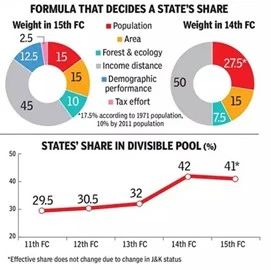Tuesday, 18th June 2024
Urgent Need for a National Security Doctrine in India
Why in the news ?
- Recently, the Chief of Defence Staff (CDS) emphasised the necessity of formalising India's National Security Strategy (NSS).
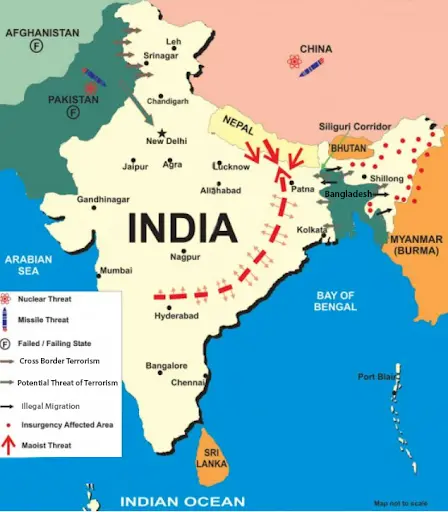
CDS Calls for Debate on Formalizing India’s National Security Strategy:
- The CDS outlined key components of the NSS: Policy, Processes, and Practices.
- He acknowledged India's effective management of policy, processes, and practices.
- However, he identified the absence of a formal written policy as a significant gap in India's NSS.
- He questioned the need for a written policy, citing Israel's operational model without one.
- This has sparked renewed analysis and debates on whether India should have a formal written national security strategy.
|
About National Security Strategy (NSS):
|
The need for a National Security Strategy (NSS) in India:
- Enhancing Operational Effectiveness: NSS should define clear objectives, strategies, and resource allocations to promote delegation, synergy, and operational autonomy. It aims to foster initiative, innovation, and improvisation at the frontline level.
- Crucial for Effective Theatre Commands: NSS is essential for establishing and enhancing the effectiveness of theatre commands and overall military transformation.
- Inspiring Military Leadership: A well-defined NSS is expected to inspire bold and capable military leaders, akin to Field Marshal ‘Sam’ Manekshaw, Lt Gen Harbaksh Singh, and Lt Gen Sagat Singh.
- Promoting ‘Whole of Nation’ Approach: A robust NSS promotes a "whole of nation" approach, synergizing comprehensive national power (CNP) across various sectors.
- Facilitating Capacity Building: NSS enables setting milestones for capability-building, modernization, infrastructure development, and the Atma Nirbhar mission.
- Addressing Defence Planning Concerns: Current discontinuation of Defence Plans and challenges with new formats like Integrated Capability Plan and Defence Capability Acquisition Plan highlight the need for NSS to provide clarity and direction.
- Enhancing Accountability: NSS could improve parliamentary reviews and audits by providing a clear framework for evaluation. It allows for external expert scrutiny and peer reviews, fostering transparency and accountability in national security planning.
Issues and concerns surrounding India’s National Security Strategy (NSS):
- Prolonged Drafting of Multiple Versions: The prolonged drafting of multiple versions of NSS over two decades raises doubts about its purpose and effectiveness.
- Establishment of Defence Planning Committee: The establishment of the Defence Planning Committee chaired by the National Security Advisor in 2018 aimed to formulate NSS and National Defence Strategy, but progress has been slow.
- Transparency Issues: There is a lack of transparency regarding the status and progress of NSS despite its public announcement and importance.
- Challenges with Operational Directive: Current reliance on the cryptic and inadequate Operational Directive of the Defence Minister highlights the need for a comprehensive NSS.
- Unclear Strategic Guidance: Concerns persist about unclear strategic guidance for Army Commanders, with substantive handover procedures often being brief and ceremonial.
|
Attempts to formulate a National Security Strategy (NSS) in India:
|
Conclusion
India requires a tailored strategy to effectively address its distinct security challenges. Resolving issues related to the National Security Strategy (NSS) is imperative to improve strategic clarity and operational preparedness in safeguarding national interests.
|
UPSC Civil Services Examination Previous Year Question (PYQ) Prelims Q:1 With reference to the ‘Trans-Pacific Partnership’, consider the following statements: (2016)
Which of the statements given above is/are correct?
Ans: D Mains : Q:1“The diverse nature of India as a multi-religious and multi-ethnic society is not immune to the impact of radicalism which is seen in her neighbourhood.” Discuss along with strategies to be adopted to counter this environment. (200 words) [2014] |
Souce: IE
Kafala System
Why in the news?
- The recent fire in Mangaf, Kuwait and the 49 deaths of Indian migrant workers underscores the poor living conditions and neglect of low-income workers’ rights and well-being in GCC states.
Kafala System:
- The Kafala system, prevalent in the GCC states, is a complex of laws and practices that ensure the state and citizens hold all the power. At the same time, individual migrants are treated as temporary.
- It ties migrant workers’ visas to their employers and allows employers significant control over workers’ lives, including housing, food, and transportation.
- This system is the root cause of the vulnerability and exploitation of migrant workers in the region.
- Low wages and restricted movement prevent workers from challenging poor conditions.
- During the COVID-19 pandemic, GCC states, including Kuwait, confined migrants in crowded accommodations, limiting access to services and deporting thousands.
Gulf Cooperation Council (GCC):
- The GCC was established in 1981 and currently consists of six Arab countries: Bahrain, Kuwait, Oman, Qatar, Saudi Arabia, and the United Arab Emirates. The council’s main headquarters is located in Riyadh, Saudi Arabia.
- It was formed to address regional challenges faced by the Arab States of the Gulf.
Migrants’ Rights in GCC countries:
- Vulnerabilities of Migrant Workers: Migrants in GCC countries are vulnerable under the Kafala system, linking legal status to employers who control housing, wages, and mobility. This dependency leads to exploitation, poor conditions, and arbitrary deportations.
- Living Conditions and Safety: Many migrants live in overcrowded and substandard housing, increasing risks during emergencies like the Mangaf fire. Workplace and living safety standards are often inadequate, jeopardising migrant health.
- Legal Protections and Access to Justice: Migrant workers, especially domestic workers, face inconsistent legal protections and are often excluded from labour laws. Limited access to justice and barriers to organising further hinder their rights advocacy.
India-GCC Relations:
- Strategic Importance:
- Geographical Proximity: The GCC borders India across the Arabian Sea, making it a close neighbour.
- Energy Security: The GCC’s substantial oil and gas reserves are crucial for India’s energy needs.
- Large Indian Expatriate Community: Millions of Indians (diaspora) live and work in GCC countries.
- Shared Strategic Goals: Both India and the GCC desire regional stability and security.
- Economic and Commercial Relations:
- India’s economic linkages with the GCC have increased steadily, especially due to growth in oil imports.
- During FY23, India-GCC bilateral trade stood at US$ 184.55 billion.
- GCC is India’s largest bloc trading partner.
- Four India-GCC Industrial Conferences have been held to promote industrial cooperation.
|
UPSC Civil Services Examination PYQ Mains: Q:1 Indian Diaspora has an important role to play in South-East Asian countries’ economy and society. Appraise the role of the Indian Diaspora in South-East Asia in this context. (2017) |
Source: TH
50th G7 Summit
Why in the news ?
- Recently, Prime Minister Narendra Modi attended the 50th G7 Summit in Puglia, Italy.
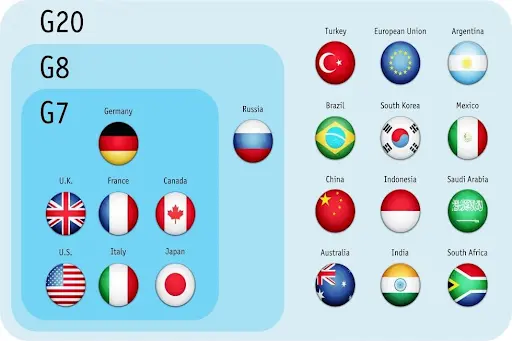
What are the Key Agendas of the G7 Summit ?
- Supporting Ukraine: In response to the ongoing war, the G7 will unveil a new initiative called "Extraordinary Revenue Acceleration (ERA) Loans." This aims to provide Ukraine with an additional $50 billion by year's end to bolster its defence efforts.
- Mideast Peace Efforts: The G7 will turn its attention to the conflict in Gaza, with the US President proposing an immediate ceasefire plan between Israel and Hamas.
- Addressing the Migration Challenge: Italy is pushing for European cooperation in managing irregular migration from Africa. The "Mattei Plan" proposes significant investments in African infrastructure, development, and energy to tackle the root causes of migration.
- Combating Climate Change: The G7 aims to significantly cut emissions by 2030, aiming for a 40-42% reduction. As current policies only project a 19-33% decrease, the summit will explore new strategies to achieve their ambitious climate goals.
- Global Infrastructure Development: The G7 nations are committed to promoting concrete infrastructure projects like the India-Middle East-Europe Economic Corridor (IMEC) and the Partnership for Global Infrastructure and Investment (PGII). These initiatives aim to improve global connectivity and boost economic growth.
- Focus on the Indo-Pacific Region: The strategic importance of the Indo-Pacific region, particularly for Japan, will be a key discussion point. This region is expected to be a major driver of future global growth and security.
|
G7 Summit:
|
Why has been India invited?
- India has been invited to the G7 summit for several compelling reasons. Firstly, with a GDP of $3.94 trillion, India's economy surpasses that of four G7 member nations. This economic stature underscores India's significant role as a major global economic player.
- Strategically, India holds pivotal importance in the Indo-Pacific region, where it acts as a counterbalance to Chinese influence. This geopolitical positioning enhances India's relevance in discussions concerning regional stability and global security.
How relevant is it today?
- Today, the relevance of India's participation in the G7 is underscored by the evolving global economic landscape.
- While the G7 collectively represents around 47% of global GDP, only five members—US, Germany, Japan, UK, and France—are ranked among the top seven global economies.
- Both Italy and Canada have been surpassed by China and India, highlighting the shifting economic dynamics where India's influence and economic potential are increasingly recognized on the global stage.
|
UPSC Civil Services Examination, Previous Year Questions (PYQs) Prelims Q:1 The term ‘Intended Nationally Determined Contributions’ is sometimes seen in the news in the context of (2016)
Answer: (b) Q:2 With reference to the Agreement at the UNFCCC Meeting in Paris in 2015, which of the following statements is/are correct? (2016)
Select the correct answer using the code given below.
Answer: (b) Q:3 In which one of the following groups are all the four countries members of G20? (2020)
Ans: (a) Mains Q:1 ‘Climate change’ is a global problem. How will India be affected by climate change? How Himalayan and coastal states of India are affected by climate change? (2017) Q:2 Describe the major outcomes of the 26th session of the Conference of the Parties (COP) to the United Nations Framework Convention on Climate Change (UNFCCC). What are the commitments made by India in this conference? (2021) |
Source: TH
India-Italy Strategic Partnership
Why in the news ?
- Recently, prime minister Narendra Modi met his Italian counterpart to discuss a free and open Indo-Pacific and the India-Middle East-Europe Economic Corridor.

- Prime Minister Narendra Modi and his Italian counterpart reviewed the progress of the bilateral strategic partnership, agreeing to strengthen cooperation in global fora and multilateral initiatives, including the India-Middle East-Europe Economic Corridor.
India-Italy Strategic Partnership:
- India-Italy Strategic Partnership and Indo-Pacific Engagements
- In 2023, India and Italy upgraded their relationship to a Strategic Partnership, marking a significant milestone in their bilateral ties.
- Italy has shown growing interest in the Indo-Pacific region, joining other European countries like France, Germany, and The Netherlands in engaging with this strategic area.
- This shift reflects Italy's recent pivot towards the Indo-Pacific, highlighting its efforts to strengthen relations with India.
- Trilateral Initiatives and Global Forums:
- In 2021, the ‘India-Italy-Japan’ trilateral was initiated to enhance security, stability, prosperity, and multilateralism in the Indo-Pacific region.
- This collaboration is the second of its kind involving India and a European nation in the Indo-Pacific, following the ‘India-France-Australia’ trilateral.
- Italy has also joined significant global initiatives launched during the G20 Summit, including the ‘Global Biofuel Alliance’ and the ‘India-Middle East-Europe Economic Corridor’.
- In 2021, Italy became a member of the ‘International Solar Alliance’ (ISA) during its G20 Presidency and co-Presidency of COP26.
- Economic and Trade Relations:
- Bilateral trade between India and Italy experienced significant growth, reaching approximately 4.9 billion Euros in 2022, a 42% increase from 2021. Italy ranks as India’s fifth-largest trading partner within the EU.
- Both nations aim to strengthen cooperation in defence technology, maritime security, and space, addressing shared maritime concerns.
- Relations with China and Geopolitical Shifts:
- Italy's increasing concerns about China's influence in the broader European and Indo-Pacific regions have influenced its foreign policy.
- Reports suggest that Italy may exit China’s Belt and Road Initiative (BRI), indicating a significant policy shift. These geopolitical dynamics are prompting Italian policymakers to reshape their relationships in Asia.
Way Ahead:
- Recent developments indicate a renewed interest in strengthening the India-Italy relationship from both sides.
- By leveraging their strategic positions in the Indian Ocean and the Mediterranean, India and Italy can enhance connectivity, stability, and energy security.
- Promoting freedom of navigation in these maritime geographies will contribute to broader stability in the Indo-Pacific region.
Source: TH
Environmental Performance Index 2024
Why in the news ?
- Recently, the Yale Center for Environmental Law and Policy and the Columbia Center for International Earth Science Information Network have released the Environmental Performance Index (EPI) for 2024.
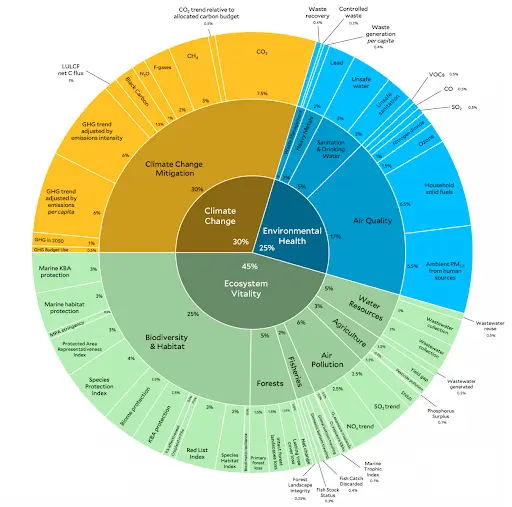
What are the Key Highlights of EPI 2024?
- Global Scenario:
- Estonia leads the index by reducing its greenhouse gas emissions by 59% from 1990 levels.
- The report indicates that only five countries — Estonia, Finland, Greece, Timor-Leste, and the United Kingdom — have cut their GHG emissions at the necessary rate to reach net zero by 2050.
- Sub-Saharan Africa and Southern Asia rank lowest among the eight regions assessed.
- Apart from the United Kingdom, countries identified in the 2022, this report as being on track for net zero emissions by 2050 have either seen slow progress, like the United States, or have increasing emissions, as seen in China, India, and Russia.
- India’s Performance:
- India ranks 176th out of 180 countries with 27.6 points, placing above only Pakistan, Vietnam, Laos, and Myanmar.
- It performs poorly in Air Quality, Emissions, and Biodiversity Conservation, largely due to its heavy reliance on coal, which significantly contributes to greenhouse gas emissions and air pollution levels.
- Specifically, India ranks 177th in air quality and 172nd in projected emissions by 2025.
- The Largest Emitter Of Transboundary Pollution:
- In South Asia, India is identified as the largest emitter of transboundary pollution, impacting neighbouring Bangladesh and affecting residents' well-being.
- Despite its low overall ranking, India fares relatively better (133rd) in the climate change category, due to investments in renewable energy and a commitment to achieving net-zero emissions by 2070.
- Achieving these goals will require an additional USD 160 billion annually in climate change mitigation investments.
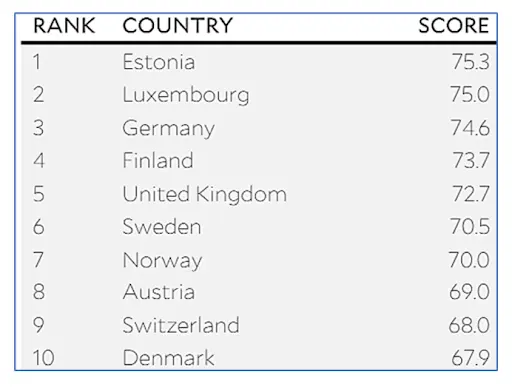
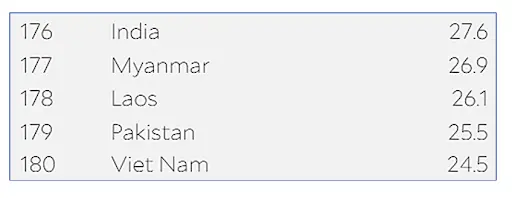
What is India's Response to EPI ?
- Projected GHG Emissions Calculation: India argues that the calculation should consider a longer period (10 to 20 years) rather than the average rate of change in emissions over the last 10 years, which it finds inadequate.
- Carbon Sinks Exclusion: India's forests and wetlands, which act as crucial carbon sinks, have not been factored into the computation of the projected GHG emissions trajectory up to 2050 in the EPI 2024.
- Ecosystem Condition Overlooked: While the index computes the extent of ecosystems, it does not evaluate their condition or productivity.
- Lack of Relevant Indicators: The index does not include important indicators such as agro-biodiversity, soil health, food loss, and waste, which are crucial for developing countries with large agrarian populations
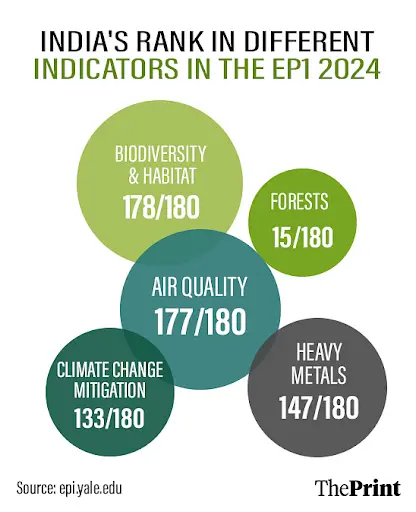
|
Environmental Performance Index (EPI):
|
What are the Challenges Related to EPI?
- Measurement Complexities:
- The challenge lies in the intricate dynamics and the lack of standardised methodologies across regions for measuring biodiversity loss and ecosystem health.
- Data Availability and Reliability:
- Some developing nations struggle with inadequate monitoring systems or difficulties in collecting comprehensive environmental data, resulting in an incomplete understanding of environmental conditions.
- Balancing National Priorities:
- Countries often prioritise economic development over environmental protection, leading to potential conflicts or resistance when implementing recommendations from the Environmental Performance Index (EPI).
- Challenges in Transitioning Industries:
- Nations heavily reliant on resource extraction or fossil fuel-based industries face significant challenges when transitioning to more sustainable practices.
- Funding and Resource Constraints:
- Developing countries may lack sufficient funds or expertise for environmental projects, hindering progress. Meanwhile, developed countries have not allocated adequate financial support to aid mitigation efforts in these nations.
- Cross-Border Environmental Impacts:
- Addressing cross-border environmental issues such as air pollution, water management, or wildlife protection often necessitates multilateral agreements and collaborative efforts among nations
|
What are the Environmental Conservation Programmes in India?
|
Way Forward:
- Enhanced Methodology and Carbon Sink: Extend the timeframe (20-30 years) for calculating projected GHG emissions instead of relying solely on the last 10 years' average rate of change.
- Recognize Carbon Sequestration Efforts: Acknowledge initiatives like the Compensatory Afforestation Fund Management and Planning Authority (CAMPA) aimed at enhancing carbon sequestration.
- Broaden Indicator Set: Introduce indicators relevant to agrarian economies, such as agro-biodiversity, soil health, food loss, and waste management, to provide a comprehensive assessment.
- Tailored Indicators for India: Include metrics like organic farming area, crop diversification, and measures to reduce post-harvest losses in India's context, reflecting strides in sustainable agriculture.
- Transparent Weighting and Funding: Ensure clear explanations for changes in indicator weightings, addressing concerns raised by nations like India, to enhance credibility and accountability.
- Stakeholder Engagement: Foster consultations with government officials, experts, and stakeholders to align indicator weightings with global priorities and specific national contexts.
|
UPSC Civil Services Examination, Previous Year Question (PYQ) Prelims Q.1 Which of the following best describes/describes the aim of the ‘Green India Mission’ of the Government of India? (2016)
Select the correct answer using the code given below:
Ans: (c) Q.2 With reference to ‘Global Climate Change Alliance’, which of the following statements is/are correct? (2017)
Select the correct answer using the code given below:
Ans: (a) Mains Q:1 Describe the major outcomes of the 26th session of the Conference of the Parties (COP) to the United Nations Framework Convention on Climate Change (UNFCCC). What are the commitments made by India in this conference? (2021) |
Tarang Shakti-2024
Why in the News ?
- India is set to host its inaugural multinational air exercise, Tarang Shakti-2024, in August 2024, with participation expected from 10 countries and others as observers.

Ket facts about the Tarang Shakti:
- Inspired by the US-hosted Red Flag exercise, Tarang Shakti-2024 will be conducted in two phases.
- The first phase will take place in southern India, followed by the second phase in the western sector.
- Participating countries include Australia, France, Germany, Japan, Spain, the United Arab Emirates, the United Kingdom, and the United States. Germany will showcase its A-400M aircraft during the exercise, which is being evaluated by the Indian Air Force (IAF) under an ongoing tender for medium transport aircraft.
- Earlier, the IAF participated in the 2nd edition of Red Flag 2024 from June 4th to 14th in Alaska.
- Indian Rafale aircraft engaged in joint exercises with Singaporean and American counterparts, focusing on beyond-visual-range combat manoeuvres in offensive counter-air and air defence roles within large-scale operational scenarios.
Significance of the Exercise:
- Showcasing Advanced Military Technologies: Tarang Shakti-2024 serves as a platform for demonstrating advanced military technologies and capabilities, such as fighter jets, transport aircraft, and aerial refuelling systems.
- Demonstrating Effectiveness and Interoperability: Participating countries can showcase the effectiveness and interoperability of their equipment in multinational operational scenarios, fostering mutual understanding and collaboration.
- Enhancing Regional Stability: The exercise contributes to enhancing regional stability, particularly in the Indo-Pacific region, by improving collective security capabilities and readiness among participating nations.
- Strengthening Diplomatic Relations: Tarang Shakti-2024 reinforces India’s position as a crucial partner in global security initiatives. It also strengthens diplomatic ties with participating countries through collaborative defence engagement
|
UPSC Civil Services Examination PYQ Prelims Q:1 Which of the following statements about the Exercise Mitra Shakti-2023 is/ are correct?(2024)
Select the answer using the code given below:
Answer: D |
Democratisation of Technology (DoT)
Why in the news ?
- Recently, PM urged for Democratisation of Technology at G7 Outreach summit
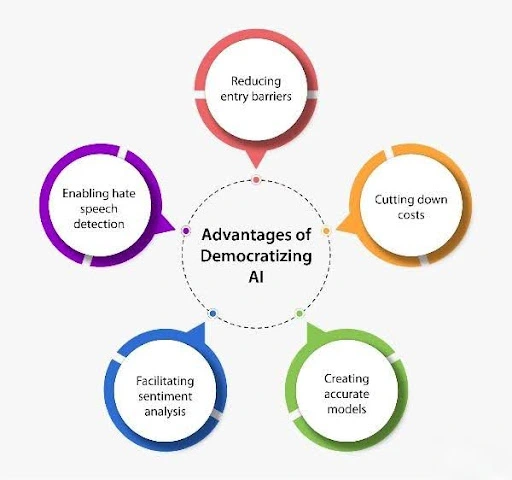

About the Democratisation:
- Democratisation of Technology (DoT) refers to the process by which access to technology becomes more widespread among the larger population.
Some key facets of DoT:
- Accessibility: Ensuring that technological tools and resources are available to a broader audience, regardless of location or socioeconomic status.
- Affordability: Making technology more affordable so that it can be accessed by individuals and organisations with varying financial means.
- Decentralisation: Distributing technological resources and decision-making processes to reduce central control and enhance local empowerment.
- Skill Development: Providing education and training to equip people with the skills needed to use and benefit from technology effectively.
- Shared Resources: Promoting the use of shared technological resources, such as open-source software and communal hardware, to maximise utility and collaboration.
Significance of Democratisation of Technology (DoT):
- Economic Impact: Empowers individuals and small businesses to use tech platforms for starting new ventures and driving innovation. Fosters economic growth, job creation, and new income opportunities across various sectors.
- Social Impact: Bridges digital divides, providing access to educational resources, healthcare information, and financial services. Enhances social mobility, exemplified by initiatives like Massive Open Online Courses (MOOCs) offered by NPTEL.
- Cultural Impact: Platforms like Twitter and Instagram amplify diverse voices and enable global sharing of cultural content. Promotes cultural exchange and understanding through accessible digital mediums.
- Governance Impact: Enhances citizen engagement and public discourse, leading to greater accountability in governance. Utilises social media outreach to connect public services with beneficiaries, improving transparency and efficiency.
Challenges in Democratisation of Technology (DoT)
- Digital Divide and Infrastructure Gap: Lack of reliable and affordable internet connectivity, especially in remote and rural areas, hinders widespread access.
- Gender and Social Inequities: Persistent gender disparities in access to education, employment, and resources exacerbate the digital divide.
- Cybersecurity and Privacy Concerns: Issues such as data privacy, online fraud, and cyber threats deter individuals and organisations from fully embracing technology.
Steps Taken for Democratisation of Technology (DoT) in India:
- Digital Public Infrastructure: Implementation of the 'India Stack', a comprehensive digital framework for digital identification (Aadhaar), payments (UPI), and data management, enabling broad access to essential services.
- Common Service Centres (CSCs): Establishment of access points for Government-to-Citizen (G2C) e-Services, creating physical service delivery ICT infrastructure within reach of citizens, especially in rural and remote areas.
- NAMO Drone Didi Initiative: Support for women self-help groups (SHGs) to purchase drones for agricultural purposes, empowering women and promoting tech adoption in farming. #BBD0E0 »
Bengaluru Municipal impose Solid Waste Management Cess
Why in the news ?
- Recently, Bruhat Bengaluru Mahanagara Palike (BBMP) has proposed a Solid Waste Management (SWM) Cess of ₹100 per month for each household.

- The proposed SWM Cess represents a substantial increase from the previous user fees typically charged by ULBs (Urban Local Bodies) across India, which are generally in the range of ₹30-50 per month.
- The SWM Cess directly affects every household in Bengaluru, potentially adding financial burden on residents.
About the Cess and Solid Waste :
- Cess : A cess is a type of tax or levy imposed by governments to fund specific services or purposes, such as waste management or infrastructure development.
- Solid Waste : Solid waste comprises byproducts from household or commercial activities that are no longer valuable to their original owners but may be useful to others. Examples include municipal solid waste (discarded household items) and industrial waste.
Current State of Solid Waste Management (SWM) in India:
- Waste Generation: India generates approximately 160,038.9 tons of solid waste per day.
- Collection Efficiency: Around 95% of the generated waste is collected efficiently (CPCB, 2020-21).
- Waste Treatment: Of the collected waste, about 50% undergoes some form of treatment.
- Unaccounted Waste: 31.7% of the total waste generated remains unaccounted for, indicating significant gaps in the waste management process.
Challenges in Solid Waste Management (SWM) in India:
- Segregation of Waste: Inadequate segregation at the source increases the cost and complexity of waste disposal.
- Collection and Transportation: Underdeveloped infrastructure for waste storage at the source and limited door-to-door collection services.
- Disposal and Treatment: Reliance on open dumps that emit methane gas due to anaerobic decomposition of biodegradable waste, leading to fires, explosions, and contributing to global warming.
- Municipal Finance: Difficulty in generating sufficient revenue from provided services and attracting private investment due to inadequate creditworthiness and financial constraints.
Key Provisions of Solid Waste Management Rules, 2016:
- Applicability: The rules apply to municipal areas, urban agglomerations, census towns, notified industrial townships, etc., ensuring comprehensive coverage of waste management practices.
- Segregation of Waste: Waste generators are mandated to segregate waste at the source into three categories: Biodegradable, Non-biodegradable, and Sanitary and Domestic Hazardous waste.
- Collection & Disposal of Waste: Local authorities are entrusted with the responsibility of establishing robust systems for waste collection, transportation, processing, and disposal.
- Recovery and Recycling Facility: Developers of Special Economic Zones (SEZs), industrial estates, and industrial parks are required to allocate at least 5% of the total area of the plot or a minimum of 5 plots/sheds for recovery and recycling facilities.
Bengaluru's Solid Waste Management (SWM) Approach:
- Current Challenges: Bengaluru grapples with significant SWM challenges due to its large population and daily waste generation of 5,000 tonnes, necessitating substantial resources and infrastructure.
- Operational Focus: The Bruhat Bengaluru Mahanagara Palike (BBMP) prioritises waste collection and transportation, which are labour-intensive and consume a significant portion of the SWM budget.
- Financial Strain: SWM services strain BBMP's budget, with limited revenue generation. Initiatives like the SWM Cess are proposed to bridge funding gaps and ensure sustainable service delivery.
Future Plans for Bengaluru's Solid Waste Management (SWM):
- Proposed Changes:
- Bengaluru is set to implement revisions in its SWM strategy, including adjusting user fees and possibly increasing charges for bulk waste generators.
- These measures aim to improve financial sustainability and enhance service efficiency.
- Strategies for Improvement:
- BBMP plans to boost SWM practices by promoting waste segregation at source, establishing decentralised composting centres, and launching public awareness campaigns.
- These initiatives aim to optimise resource usage and enhance overall SWM effectiveness across the city.
|
UPSC Civil Services Examination PYQ Q:1 What are the impediments in disposing of the huge quantities of discarded solid wastes which are continuously being generated? How do we safely remove the toxic wastes that have been accumulating in our habitable environment? (2018) |
Source: TH
50th year of India’s saurian conservation
Why in the news ?
- Recently, the effective Crocodile Conservation Project at Bhitarkanika National Park is exacerbating human-crocodile conflicts impacting local communities.

What is the Crocodile Conservation Project ?
- Launch : The Crocodile Conservation Project began in 1975 at Bhitarkanika National Park, Odisha.
- Objective: It aims to safeguard crocodile habitats and bolster populations through captive breeding, addressing low hatchling survival rates in the wild.
- Historical Context: Launched shortly after the Wild Life (Protection) Act, 1972, the project was a response to the looming threat of extinction due to widespread hunting for commercial gain and significant habitat loss.
- Implementation: Across 34 locations in India, centres were established to breed and rear saltwater crocodiles, muggers, and gharials under the guidance of HR Bustard.
- Success: The Bhitarkanika project, led by Sudhakar Kar and HR Bustard, has been exceptionally successful, increasing the crocodile population from 95 in 1975 to 1,811 in the latest reptile census.
- Ongoing Efforts: Even after retirement, Sudhakar Kar continues to contribute technical expertise and oversee the annual census of saltwater crocodiles, underscoring his lifelong commitment to crocodile conservation.
|
IUCN Status of Crocodiles of India:
Bhitarkanika National Park:
|
What are the Issues Faced by Bhitarkanika ?
- Human-Crocodile Conflict: The increasing number of crocodiles has resulted in heightened conflicts with humans. Sudhakar Kar has expressed concern and advised locals against entering water bodies inhabited by estuarine crocodiles.
- Impact on Local Communities: Since 2014, these conflicts have resulted in 50 deaths. Local villagers have criticised politicians for not adequately addressing safety concerns, impacting political outcomes.
- Preventive Measures: Forest officials have installed barricades around 120 river ghats in and around Bhitarkanika to mitigate crocodile attacks on humans.
- Political Implications: The human-crocodile conflict has significantly influenced local political dynamics. Villagers have shown dissatisfaction with current leaders due to safety concerns related to crocodile attacks.
Conclusion:
Enhancing protective measures around water bodies with reinforced barricades and secure river ghats is essential. Establishing safe, designated areas for water-related activities can effectively reduce the risk of crocodile attacks.
|
UPSC Civil Services Examination PYQ Mains: Q:1 How does biodiversity vary in India? How is the Biological Diversity Act,2002 helpful in the conservation of flora and fauna? (2018) |
Source: DTE
Kerala Migration Survey (KMS) 2023 report
Why in the news ?
- Recently , the Kerala Migration Survey (KMS) 2023 report was unveiled at the Lok Kerala Sabha.
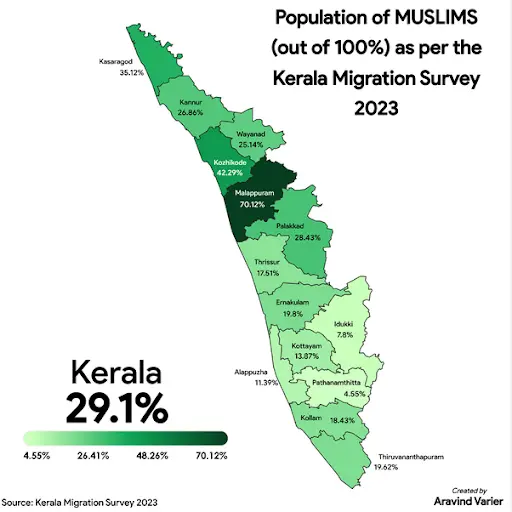
- Lok Kerala Sabha is a state government-constituted platform for Keralites abroad and in other states, i.e. non-resident Keralites.
- It is the sixth KMS conducted every five years since 1998. It was prepared by the International Institute of Migration and Development (IIMD) and the Gulati Institute of Finance and Taxation.
- The survey looked at 20,000 households from all 14 districts of Kerala, including rural and urban areas.
- KMS is among the biggest socio-economic surveys ever conducted in Kerala. The National Family Health Survey (NFHS-5) sampled only 12,330 households statewide.
Key findings:
- Total emigrants increased: The KMS 2023 estimated the number of emigrants from Kerala to be 2.2 million, slightly more than the 2.1 million recorded in 2018.
- Total emigrants returning home increased: The number of emigrants returning home has also increased, from 1.2 million in 2018 to 1.8 million in 2023.
- The decline in emigration to Gulf countries: This is in line with the declining trend seen since 1998 when GCC destinations accounted for 93.8% of Kerala’s emigrants.
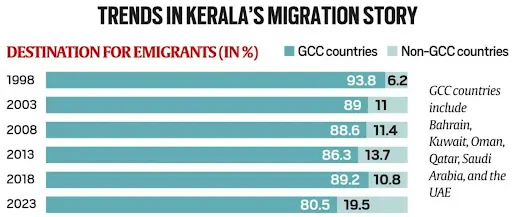
- Rising emigration beyond the Gulf: Preference for destinations beyond the Gulf Cooperation Council (GCC) countries (Bahrain, Kuwait, Oman, Qatar, Saudi Arabia, and the UAE) has grown from 10.8% in 2018 to 19.5% in 2023.
- Rising student emigration: Students constitute 11.3% of total emigrants from Kerala, with overall numbers almost doubling since 2018 — from 129,763 to 250,000.
- Rise in women emigrants: The number and proportion of women emigrants have increased, from 15.8% in 2018 to 19.1% in 2023, with 71.5% of women being graduates as against 34.7% of men.
- 40.5% of women emigrants are in Western countries, compared to only 14.6% of male emigrants.
- Around 51.6% of women emigrants work in the nursing sector.
- Women also make up 45.6% of Kerala’s student migrant population.
- Muslim emigrants: Muslims, who make up 26% of Kerala’s population (according to the 2011 census), make up 41.9% of the state’s emigrants.
- Growing remittances: Rs 216,893 crores in 2023, an increase of 154.9% from Rs 85,092 crores in 2018.
- It amounts to a per capita remittance of Rs 61,118 for the state’s population of 3.55 crores.
- Average remittance per emigrant household also increased to Rs 2.24 lakh in 2023, compared to Rs 96,185 in 2018.
Way forward
- High student migration suggests an urgent need to enhance the state’s educational infrastructure.
- Safe migration pathways for future student emigrants need to be ensured.
- “Brain drain” to “Brain gain”: It is also important to develop new policies that will encourage those studying abroad to return home after acquiring valuable skills.
- Skilling: Given that 76.9% of Kerala’s emigrants are labour emigrants, it is essential to improve and strengthen their skills to help them secure better employment opportunities and pay abroad.
Source: IE
Water Management: From Scarcity to Sustainability
Context:
- India faces an imminent water crisis due to severe water scarcity exacerbated by heat waves and erratic rainfall.
- Declining river flows and groundwater levels have worsened conditions, causing taps to run dry in cities like Bengaluru.
- Addressing this requires more than just providing tap water connections; India needs a sustainable water management policy emphasising conservation, equitable distribution, and holistic strategies.
What is the Structure of Water Management in India?
- Central Level:
- Ministry of Jal Shakti (MoJS): Established in May 2019, formulates national water policies and oversees water resource management.
- Central Water Commission (CWC): Provides technical guidance on water resource development projects and river basin planning.
- Central Groundwater Board (CGWB): Assesses, monitors, and manages groundwater resources.
- Central Pollution Control Board (CPCB): Ensures water cleanliness by preventing and reducing water pollution.
- State Level:
- State Water Resources Departments: Implement water policies and manage resources within states.
- Irrigation Departments: Manage irrigation systems and distribute water for agriculture.
- State Pollution Control Boards (SPCBs): Monitor and control water pollution.
- Local Level:
- Panchayats (Village Councils): Manage water resources, promote conservation, and ensure equitable distribution.
- Municipalities: Manage water supply and sanitation in urban areas.
- Water User Associations (WUAs): Manage local irrigation systems and maintenance
|
Constitutional Provisions Related to Water:
|
What are the Major Factors Driving Water Crisis in India?
- Largest Global Extractor: India extracts approximately 25% of the world's groundwater, causing significant depletion of aquifers.
- Agricultural Dominance: About 78% of India's freshwater is used for agriculture, mainly through flood irrigation, exacerbating water scarcity, especially in states like Punjab and Haryana.
- Inadequate Infrastructure: Aging water systems, widespread leakages, and poor maintenance contribute to substantial water loss, with Mumbai alone losing 700 million litres daily.
- Urbanization and Industry: Rapid urban growth and industrialization intensify water demand and pollution, with five of the world's 20 most water-stressed cities located in India.
- Environmental Impact: Unregulated sand mining disrupts river ecosystems and increases flood risks, exemplified by the Yamuna river's degradation.
- Governance Challenges: Fragmented water management across ministries and states leads to inefficiencies and conflicts, such as the ongoing Cauvery water dispute.
- Neglect of Demand-Side Management: Policies focus on supply expansion over demand-side measures like water-efficient technologies and recycling, with only 30% of wastewater recycled.
- Climate Threats: Rising sea levels contribute to salinization of coastal aquifers, threatening freshwater availability in states like Gujarat and Andhra Pradesh.
What are the Challenges posed by water scarcity in India ?
- Human Capital Development: Girls miss school due to the time burden of water collection, hindering their education. Waterborne illnesses from scarcity can also impair children's cognitive development.
- Long-Term Economic Risks: The World Bank predicts water scarcity could cost India up to 6% of GDP by 2050, deterring investment in water-intensive industries and impacting job creation.
- Rise of Water Mafias: In cities like Bangalore, "water mafias" control water tanker access, leading to exorbitant prices and social inequalities.
- Transboundary Water Disputes: Scarcity may escalate tensions with neighbouring countries sharing river basins like Pakistan and Bangladesh.
- Biodiversity Threat: Depleting water levels and pollution endanger freshwater species like the Ganges River Dolphin, leading to habitat loss and biodiversity decline.
|
What are the Government Initiatives To Tackle the Water Crisis in India?
|
What are the measures to tackle the water crisis ?
- Transforming Fallow Land into Recharging Units: Convert underutilised land into "water parks" with bioswales, wetlands, and rainwater harvesting to recharge aquifers.
- Desalination with Renewable Energy: Develop desalination plants powered by renewables and waste-to-energy tech for sustainable water production.
- Urban Rainwater Harvesting: Mandate rainwater harvesting in new and existing buildings, coupled with green roofs to replenish groundwater.
- Promoting Drip Irrigation and Aquaponics: Encourage drip irrigation to minimise water loss and support aquaponics for efficient water use.
- Smart Water Grids: Implement sensor-based grids for leak detection, pressure management, and efficient water distribution.
- Fog Harvesting: Explore fog harvesting technologies in hilly regions to capture moisture for water supply.
- Decentralised Water Management: Adopt community-driven approaches like the Swajal project and decentralised wastewater treatment systems.
- Public-Private Partnerships (PPPs): Encourage PPPs for water infrastructure development to leverage private sector expertise and funding.
- Zero Liquid Discharge (ZLD) for Industries: Mandate ZLD systems in industries to treat and recycle wastewater, reducing freshwater demand.
- Eco-Industrial Parks: Establish parks where industries share and reuse water resources to conserve freshwater and minimise pollution.
|
UPSC Civil Services Examination, Previous Year Question (PYQ) Prelims: Q.1. Which one of the following ancient towns is well known for its elaborate system of water harvesting and management by building a series of dams and channelizing water into connected reservoirs? (2021)
Ans: A Q.2. With reference to ‘Water Credit’, consider the following statements: (2021)
Which of the statements given above are correct?
Ans: C Mains: Q.1 What are the salient features of the Jal Shakti Abhiyan launched by the Government of India for water conservation and water security? (2020) Q.2 Suggest measures to improve water storage and irrigation system to make its judicious use under the depleting scenario. (2020) |
Source: IE
Share the article
Edukemy’s Current Affairs Quiz is published with multiple choice questions for UPSC exams
MCQ
Get Latest Updates on Offers, Event dates, and free Mentorship sessions.

Get in touch with our Expert Academic Counsellors 👋
FAQs
UPSC Daily Current Affairs focuses on learning current events on a daily basis. An aspirant needs to study regular and updated information about current events, news, and relevant topics that are important for UPSC aspirants. It covers national and international affairs, government policies, socio-economic issues, science and technology advancements, and more.
UPSC Daily Current Affairs provides aspirants with a concise and comprehensive overview of the latest happenings and developments across various fields. It helps aspirants stay updated with current affairs and provides them with valuable insights and analysis, which are essential for answering questions in the UPSC examinations. It enhances their knowledge, analytical skills, and ability to connect current affairs with the UPSC syllabus.
UPSC Daily Current Affairs covers a wide range of topics, including politics, economics, science and technology, environment, social issues, governance, international relations, and more. It offers news summaries, in-depth analyses, editorials, opinion pieces, and relevant study materials. It also provides practice questions and quizzes to help aspirants test their understanding of current affairs.
Edukemy's UPSC Daily Current Affairs can be accessed through:
- UPSC Daily Current Affairs can be accessed through Current Affairs tab at the top of the Main Page of Edukemy.
- Edukemy Mobile app: The Daily Current Affairs can also be access through Edukemy Mobile App.
- Social media: Follow Edukemy’s official social media accounts or pages that provide UPSC Daily Current Affairs updates, including Facebook, Twitter, or Telegram channels.



